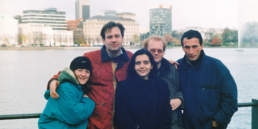One of AEGEE’s trademarks is the fact that the name of the locals contains the name of the city in its orginal language. That’s the reason why we have AEGEE-Bucureşti and not AEGEE-Bucharest and AEGEE-Roma and not AEGEE-Rome. However, there are a few interesting deviations – sometimes only on a flag (see photo above), but sometimes in the official antenna name.
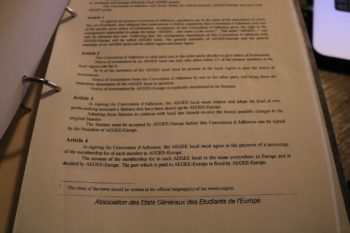
Before we get to the fun part, let’s talk about the rules. Until the beginning of the millennium, the name rule was part of AEGEE’s legal framework, the Corpus Iuridicum (CIA). For example, in CIA 6, published in 1994, the text of the Convention d’Adhésion for AEGEE Locals contained this paragraph:
Acceptance of this Convention d’Adhésion gives the right to the consignatory association to adopt the name “AEGEE-…(the name of the town)” The name of the town should be written in the official language(s) of the town’s region.. The name “AEGEE-…” can only be obtained this way.
Starting from CIA 7, also published in 1994, the name rule was demoted to a footnote. This was not unusual, since AEGEE-Europe put a lot of clarifications in CIA footnotes. For example, CIA 11 from 2001 has the following footnote text listed as footnote 17: “The name of the town should be written in the official language(s) of the town’s region.”
The rule was still binding, as the preface of every CIA until 2011 stated: “The footnotes are not part of the official text voted upon by the Agora or Presidents’ Meeting. But they are the official (and consequently binding) interpretation of the Juridical Commission in office.” However, when CIA 18 was published in 2007, all footnotes were gone. Probably one of the Juridical Commissions did not find them necessary anymore and erased them.
Nevertheless, until today the association continued to apply the name rule. With a few interesting exceptions – and also cases of a very strict application of the rule.
AEGEE-Abertawe: Do you know where Abertawe is? Maybe you know the city better as Swansea in Wales. When AEGEE-Abertawe signed the Convention d’Adhèsion in 2010, they used the Welsh name of the town. They could have used both names though, but decided differently. The local was deleted in 2013.

AEGEE-Bakı: The city name Bakı is the correct Latin transcription of the name of Azerbaijan’s capital. However, when the Contact was approved by the CD in February 2000, it was still called Contact Baku, which was the Russian name – and also internationally often used, since this area had been part of the Soviet Union. It kept the wrong name until 1st of December 2004. When they signed the Convention d’Adhésion, they changed it and called themselves AEGEE-Bakı.
AEGEE-Brussel/Bruxelles: This is a nice example of a city with two local languages – the antenna has both of them in their name. However, this local, which was founded and deleted several times, did not always have this name. In 1985 it called itself EGEE-Bruxelles, from 1992 till 1996: AEGEE-Région Bruxelloise, from 1997 until 2000 AEGEE-Bruxelles/Brussel, and after the refoundation in 2007 AEGEE-Brussel/Bruxelles. It is just a bit disturbing to see the Facebook URL: www.facebook.com/AegeeBrussels.
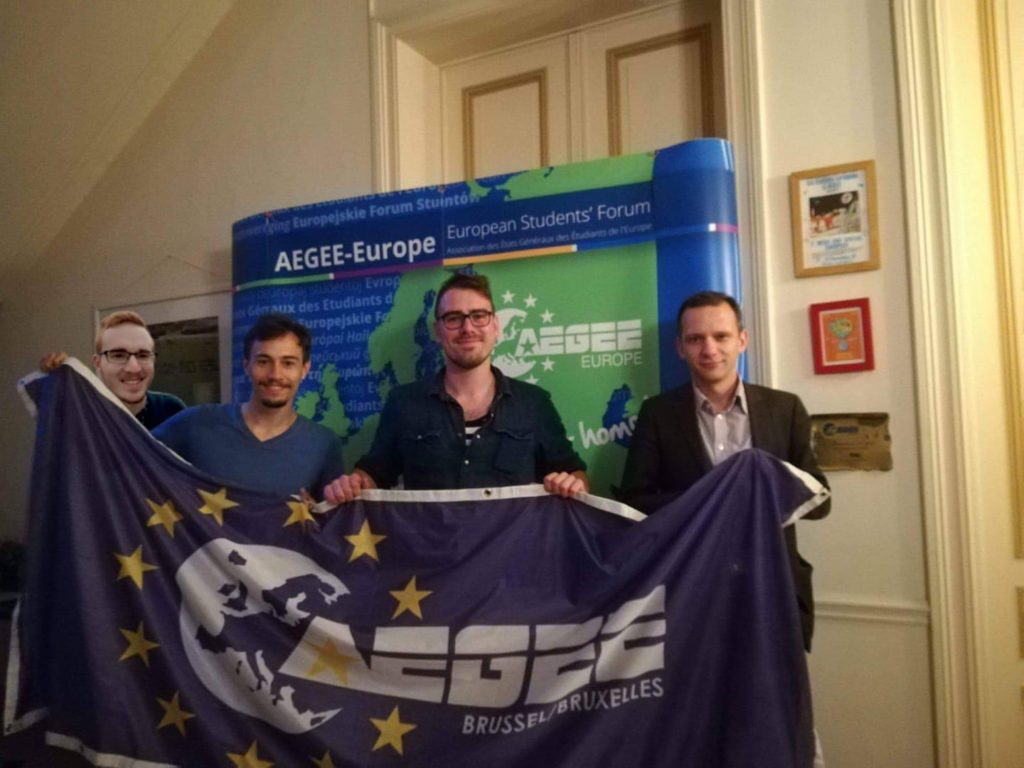
Contact Cardiff/Caerdydd: Other than AEGEE-Abertawe, the Contact of AEGEE-Europe in Cardiff opted for a double name. Well, not at first though. The first Contact in the Welsh city in 1995/96 called itself Contact Cardiff, but when it was refounded in 1997, it took on the Welsh and the English name.
AEGEE-Drogobych: When it comes to Ukrainian locals, a few of them could not really decide whether they should take the Russian name from Soviet times or the Ukrainian one. And sometimes they went mysterious ways. When students created a Contact in this town, they used the Ukrainian name Drohobych, but when they signed the Convention one year later, the local chose the name AEGEE-Drogobych, which is the Russian way. It was deleted in 2002.
AEGEE-Fribourg: There is nothing wrong here, but it is an interesting example of a local that decided to go for one language although they could have taken two. The Swiss town Fribourg is at the cultural border between French and German Switzerland. It even has the only officially bilingual German-French university in the country, according to Wikipedia. Nevertheless, they opted for the French name – maybe also to avoid confusion with AEGEE-Freiburg in Germany. AEGEE-Fribourg was founded three times, each time with this name. It was finally deleted in 2014.
AEGEE-Gəncə: Between 2004 and 2009 the Contact in this city in Azerbaijan was called Contact Ganja. Only when it was refounded and signed the Convention in 2013. It chose the correct name AEGEE-Gəncə. It was deleted in 2017.
Contact Gothenburg: AEGEE tried four times to found a local in this Swedish city: in 1994, 1996, 2002 and 2018 four Contacts were established there. The first three times under the name Contact Göteborg, but in 2018 as AEGEE-Europe Contact in Gothenburg. Let’s see whether the name will be changed to AEGEE-Göteborg when they manage to sign the Convention.
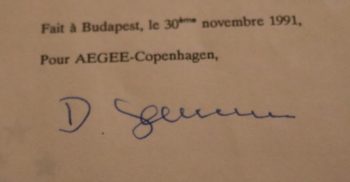 AEGEE-København: This name is correct and it has always been used in AEGEE since it was a Contact in 1991. However, when it first signed the Convention in the same year, the contract contained a substantial mistake: in the Convention the local was called AEGEE-Copenhagen. Despite of this, the local was referred to as AEGEE-København.
AEGEE-København: This name is correct and it has always been used in AEGEE since it was a Contact in 1991. However, when it first signed the Convention in the same year, the contract contained a substantial mistake: in the Convention the local was called AEGEE-Copenhagen. Despite of this, the local was referred to as AEGEE-København.
AEGEE-Luxembourg: This local – one of the oldest in the network – always had the French name, also when it was refounded in 2007. It could have also had the local name: AEGEE-Lëtzebuerg. Or the German name.After all, all three languages are official languages of the contry. It is a mere curiousity that the antenna used exclusively this Luxembourgish name when they presented their new board on AEGEE-L in March 2009. It was the last board of the local before it was deleted, by the way.
AEGEE-Lefkosia: When AEGEE reached Cyprus, AEGEE-Mağusa chose the Turkish name and of course not the English name AEGEE-Famagusta. In a similar fashion, the founders of the Contact in Nicosia chose the name Contact Lefkosia in 1999, which is the Greek name of the capital. They signed the Convention in 2002. AEGEE-Lefkosia was deleted five years later. In 2012 and in 2017 two new Contacts were founded there – but this time as Contact Nicosia…
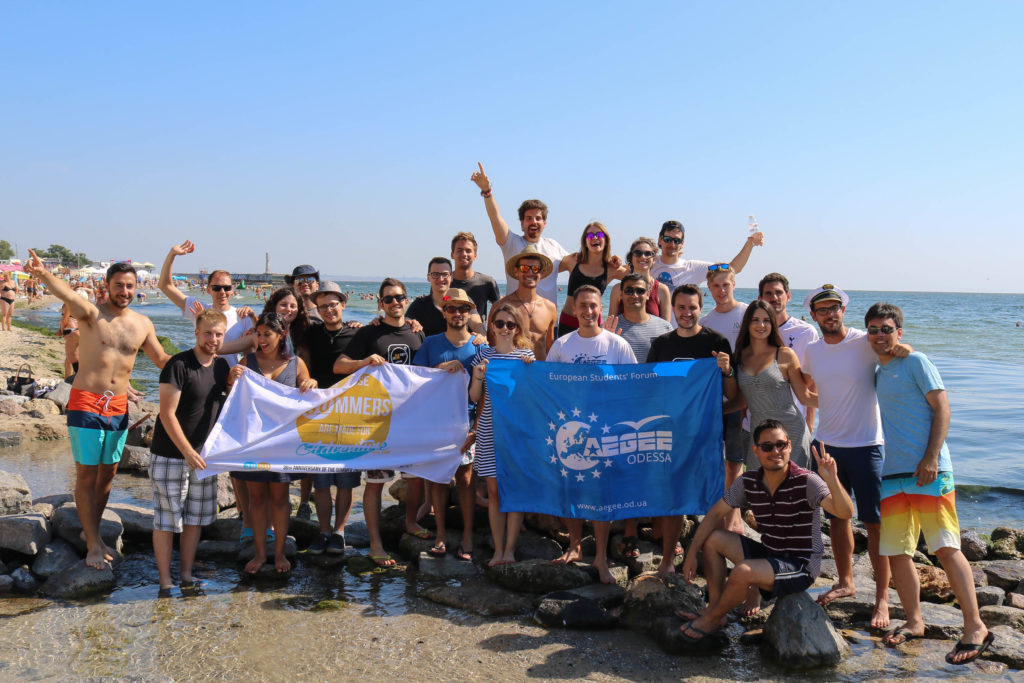
AEGEE-Odessa: When you visit this beautiful Ukrainian city, you will notice that the city used the name Odesa with one S – which is the correct Ukrainian name. The version with two S is the Russian spelling. The first Contact in this city, which existed from 1998 to 2002, was actually called Contact Odesa. When other people founded it again one year later, the used the Russian spelling, which sticked also when it signed the Convention in 2003.
AEGEE-Rostov-na-Donu: Founded in 2012, this Russian local uses the correct name in local language. This was different when it was founded for the first time, back in 2004. The Contact called itself Contact Rostov-on-Don – and stayed like this until 2006, when the Contact was deleted.
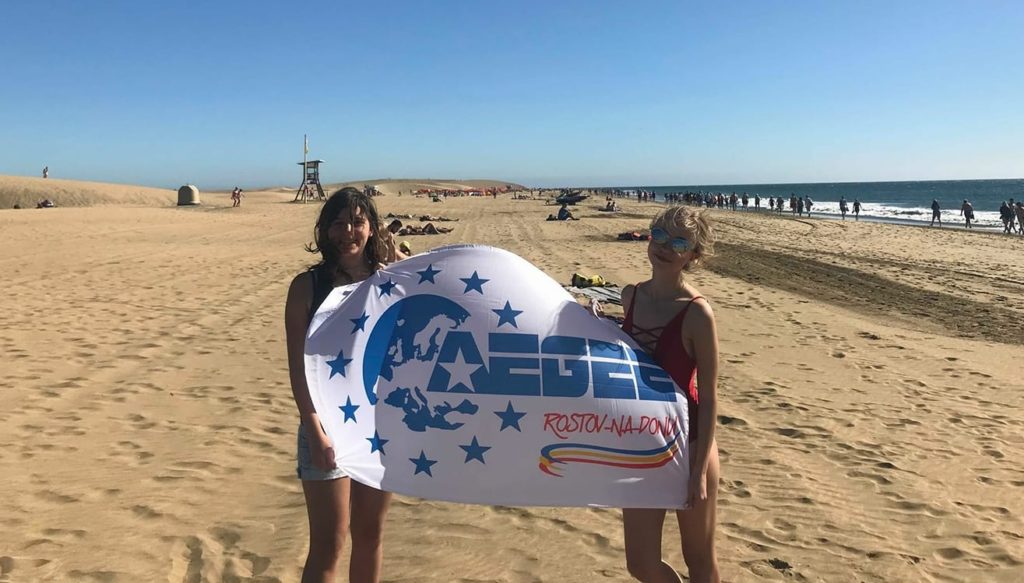
AEGEE-Tenerife: You probably know AEGEE-Las Palmas, based on Gran Canaria in the Canary Islands. The neighbouring island is Tenerife. Also there is a university, in La Laguna. And: there actually was an AEGEE-La Laguna, founded in 1989 and deleted in 1994. However, when AEGEE was founded again on the island, it did not choose the name of the university city, but instead called itself AEGEE-Tenerife, which is actually not according to the name rule – because the island name is not a city name. After all, we do not call AEGEE-Las Palmas AEGEE-Gran Canaria or AEGEE-Valletta AEGEE-Malta.
AEGEE-Turku/Åbo: This is a positive example about inclusion. The oldest Finnish city Turku is called Åbo in Swedish. And despite the fact that Swedish is a minority language in Finland, the founders of AEGEE-Turku/Åbo opted for the double name in 1990, respecting the minority in their country.
 AEGEE-Kadıköy: Let’s conclude this overview with a very special case, which is actually not a language issue. Kadıköy is not an own city, but part of the Istanbul municipality. It is the centre of the Asian side of the city. Since AEGEE locals always have to have the name of a city in its name, this local should not have existed. So what happened? Something very common: when AEGEE members are not happy with their antenna leadership, they sometimes created an own local. AEGEE-Kadıköy was basically a group of AEGEE-Istanbul members, who managed to sign the Convention in 1997. In 1999 it was deleted again, when the members stopped being active. It’s not the only case: the most prominent example is probably AEGEE-Budapest in the 1990s. Some unhappy members took over the preexisting AEGEE-Eger, which did not have local members anymore, others took over AEGEE-Szekesfehérvár. And students of the Central University in Budapest decided to create their own local in the town Gödöllö, where the CEU dormitory was located.
AEGEE-Kadıköy: Let’s conclude this overview with a very special case, which is actually not a language issue. Kadıköy is not an own city, but part of the Istanbul municipality. It is the centre of the Asian side of the city. Since AEGEE locals always have to have the name of a city in its name, this local should not have existed. So what happened? Something very common: when AEGEE members are not happy with their antenna leadership, they sometimes created an own local. AEGEE-Kadıköy was basically a group of AEGEE-Istanbul members, who managed to sign the Convention in 1997. In 1999 it was deleted again, when the members stopped being active. It’s not the only case: the most prominent example is probably AEGEE-Budapest in the 1990s. Some unhappy members took over the preexisting AEGEE-Eger, which did not have local members anymore, others took over AEGEE-Szekesfehérvár. And students of the Central University in Budapest decided to create their own local in the town Gödöllö, where the CEU dormitory was located.

